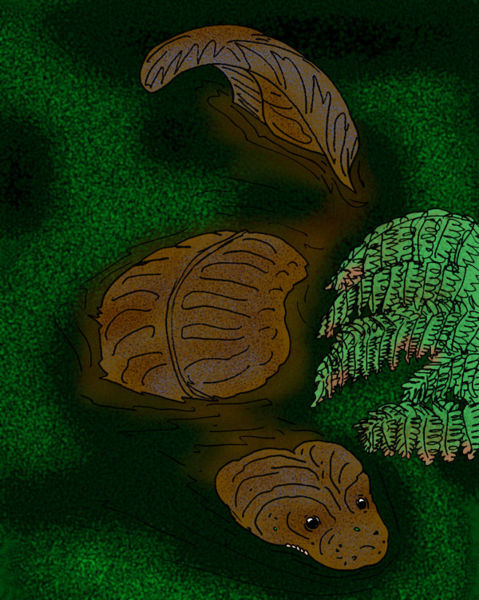- Koolasuchus
Taxobox
name = "Koolasuchus"

image_caption = "Koolasuchus cleelandi"
fossil_range = MiddleCretaceous
regnum =Animal ia
phylum = Chordata
classis = Amphibia
ordo =Temnospondyli
subordo =Limnarchia
superfamilia =Brachyopoidea
familia =Chigutisauridae
genus = "Koolasuchus"
species = "K. cleelandi"
binomial = "Koolasuchus cleelandi""Koolasuchus" was a large
Cretaceous amphibian that lived on the continent ofAustralia . It was acarnivore whose diet includedturtle s,clam s andcrayfish ."Koolasuchus" was a member of the
temnospondyli order of amphibians and specifically of thechigutisauridae family. It lived in therift valley where southern Australia was starting to split fromAntarctica , and perhaps elsewhere. It is notable both because it was one of the largesttemnospondyl s, and because it survived long after its cousins further north had become extinct.Competition with
phytosaur s during the lateTriassic , and later,crocodilian s is believed to have contributed to the general decline of the temnospondyl order. At this point in time Australia was within the Antarctic Circle, and had a climate too cold for crocodiles, protecting them from this competition. "Koolasuchus" could survive in this colder climate because, like modernsalamanders , it is thought to have hibernated under the ice in ponds during the winter."Koolasuchus" shared with older temnospondyls a very wide, heavy skull (50 centimeters/20 inch wide) which contrasted with its small weak body and limbs. Like modern crocodiles, "Koolasuchus" had its eyes on the top of its head. This suggests that it was an ambush hunter. Around 5 metres (16 ft) long but only 30cm (1 ft) high, and with a weight of more than half a ton, it would have been able to hunt
mammals or smalldinosaur s who drank from the shallow swamps and rivers it lived in to supplement its diet. Due to its extremely large head and mouth, it may have been able to capture fish and shellfish by lying in wait and suddenly opening its mouth, sucking in water and its victim. This is a feeding style similar to that of the unrelated modern-daygiant salamander s of Asia."Koolasuchus" is named for the
palaeontologist Lesley Kool andgeologist Mike Cleeland . Its remains were found in 1989 near San Remo,Victoria, Australia . [cite web
title=Life in the Shadows, Non-reptilian life in Mesozoic Australia
url=http://www.geocities.com/dannsdinosaurs/non-rept.html
publisher=geocities
accessdate=2008-08-09]References
Wikimedia Foundation. 2010.
